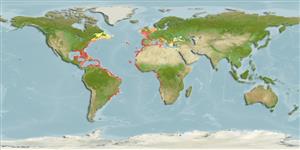Classificação / Names
Common names from other countries
Referência principal
Tamanho / Peso / Idade
Max length : 122 cm TL macho/indeterminado; (Ref. 26340); common length : 80.0 cm TL macho/indeterminado; (Ref. 5217); Peso máx. publicado: 16.5 kg (Ref. 40637); Idade máx. registada: 10 anos (Ref. 28173)
Length at first maturity
Lm 41.8 range ? - 60 cm
Ambiente
; marinhas; estuarina associadas(os) a recifes; oceanódromo (Ref. 51243); intervalo de profundidade 1 - 150 m (Ref. 28173)
Clima / Intervalo
Tropical, preferred 24°C (Ref. 107945); 56°N - 30°S, 92°W - 42°E
Distribuição
Atlantic Ocean: in tropical and subtropical waters, including the Mediterranean, Black Sea, Caribbean Sea and Gulf of Mexico. Highly migratory species, Annex I of the 1982 Convention on the Law of the Sea (Ref. 26139).
Países | Áreas FAO | Ecossistemas | Ocorrências | Introduções
Descrição breve
Espinhos dorsais (total): 15 - 16; Raios dorsais moles (total): 11-13; Espinhos anais 0; Raios anais moles: 11 - 15; Vértebras: 39. Anterior spines of first dorsal fin much higher than the those mid-way, giving the fin a strongly concave outline. Interpelvic process small and bifid. Body naked except for corselet and lateral line. Swim bladder absent. Incipient protuberances on 33rd and 34th vertebrae. Back with broken oblique stripes (Ref. 168). Caudal peduncle with 7-8 finlets. Dark stripes on the back and with 3-7 dark spots between pelvic and pectoral fins (Ref. 35388).
Categoria na Lista Vermelha da IUCN (Ref. 115185)
Ameaça para o homem
Reports of ciguatera poisoning (Ref. 30303)
Utilização humana
Pescarias: espécies comerciais; peixe desportivo: sim
Ferramentas
Relatórios especiais
Descarregue XML
Fontes da internet
Estimates of some properties based on models
Phylogenetic diversity index
PD50 = 0.6250 many relatives (e.g. carps) 0.5 - 2.0 few relatives (e.g. lungfishes)
Nível Trófico
4.5 ±0.0 se; Based on diet studies.
Resiliência
Médio, tempo mínimo de duplicação da população 1,4 - 4,4 anos (K=0.13-0.22; tm=2; tmax=8; Fec=71,000)
Vulnerabilidade
High vulnerability (57 of 100)
Categoria de preço
